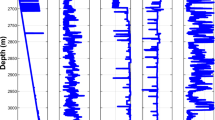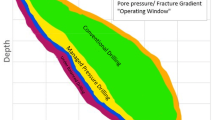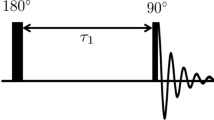Abstract
By applying high-definition induction logging (HDIL), we can precisely obtain flushed zone, transitional zone, and true formation resistivity profiles. HDIL has a distinct advantage in oil and water bed identification. However, when there is a low resistive zone in the reservoir, array induction logging is disabled to identify fluid. Two-parameter recognition was modified, which has a perfect effect in recognizing low-resistivity oil layer and low-resistivity belt zone; accuracy was 100 %. Two-parameter method supplies technological support in finding subtle oil layer and provides ideas for other array logging as well.











Similar content being viewed by others
References
Barger TD, Rosthal RA (1991) Using a multiarray induction tool to achieve high-resolution logs with minimum environmental effects. The 66th SPE Annual Technical Conference and Exhibition
Ding Y, Shao W, Li Q et al (2009) A method to identify the reservoir fluid characteristics with the array induction logging technique. Well Logging Technol 33(3):238–242
Dong J, Liao D, Jiang Y (2009) The simple exploration of the formation mechanism of the low resistivity belt zones. Pet Instrum 23(6):19–23
Ji J, Chen Y, Cai Y (2005) Using the array induction logging to identify the reservoir fluid characteristics quickly. Well Logging Technol 29(1):32–34
Lang F, Liu J, Sun S et al (2005) The application of array induction logging in difficult reservoir development. Daqing Pet Explor Dev 25(6):87–89
Liang Q, Shao W, Wang Z (2003) The application of high-resolution array induction logging in the reservoir evaluation. Well Logging Technol 27(3):228–232
Liu Z, Lin H (2002) Joint inversion of induction/lateral/normal logs, case studies at Shengli field site. China J Pet Sci Eng 34(1):55–64
Liu H, Liu Y, Zhang L (2009) Evaluation of fluid property in low-resistivity reservoir by array induction. J Chongqing Inst Technol (Nat Sci) 38(6):30–31
Qiu H (2006) The application of array induction logging in low resistivity reservoir. World Logging Technol 26(2):31–34
Smits J W, Dubourg I (1998) Improved resistivity interpretation utilizing a new array laterolog tool and associated inversion processing. SPE49328
Xu C, Peng H, Shen Y (2007) The application of high resolution induction logging in the oil and gas formation evaluation. Fault Block Oilfield 14(1):86–89
Yong S, Zhang C (1996) Logging data processing and integrated interpretation. Petroleum University Press, Dongying
Zhou F, Jiang H, Wang L et al (2011) The SVB fluid identification method based on array induction logging. Ocean Univ China 2011(S1):317–323
Author information
Authors and Affiliations
Corresponding author
Rights and permissions
About this article
Cite this article
Deng, R., Guo, H. & Xiao, C. Apply array induction logging to study the low-resistivity belt zone identification method. Arab J Geosci 7, 3409–3416 (2014). https://doi.org/10.1007/s12517-013-1049-4
Received:
Accepted:
Published:
Issue Date:
DOI: https://doi.org/10.1007/s12517-013-1049-4




